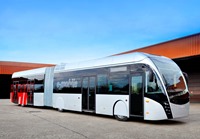
Articulated trambus platform takes on a new dimension with the addition of a fully electric drive option
FRANCE Van Hool will showcase its first fully electric Exqui.City, at Transports Publics 2016, the international trade fair for public transport, which is being held in Paris from June 14 to 16.
The 18.61m-long ‘trambus’ carries 107 passengers and has a range of 120km. An order for two fully electric Exqui.Citys will be completed this summer for Verkehrsbetriebe Hamburg- Holstein GmbH (VHH), a public transport company from Hamburg, Germany.
Exqui.City is a multi-propulsion platform where various eco- friendly propulsion systems and configurations can be specified. They range from trolleybus to hybrid systems (diesel-electric, CNG-electric), fuel cells and batteries.
Customers are free to opt for the vehicle propulsion system that best suits their needs (capacity, any existing infrastructure) and the topography of the environment where the vehicle will be deployed.
Since the presentation of the basic concept for this vehicle in Dubai in 2011, 109 Exqui.Citys with a length of 18m (articulated) up to 24m (double-articulated) VHH from Hamburg is to receive two fully electric Van Hool Exqui.Citys. VAN HOOL have been delivered to eight cities, namely Metz (France), Parma (Italy), Barcelona (Spain), Geneva (Switzerland), Malmö (Sweden), Bergen (Norway), Martinique (France) and Luxembourg (Luxembourg). A further 50 are currently being manufactured at Van Hool’s factory in Koningshooikt for Linz (Austria) and Belfast (UK), and the finishing touches are being applied to the second vehicle for Hamburg (Germany).
The fully electric Exqui.City is equipped with a lithium-ion battery with a storage capacity of 215kWh giving it a range of 120km. The battery powers two electric water-cooled motors from the central Siemens ELFA two series, each with a capacity of 160 kW. The battery is mounted on the roof and can be conductively charged in two ways, either by an external pantograph (installed at the terminus) that’s lowered from above onto insulated V-shaped charging rails on the roof or the vehicle can be connected up to the electricity grid by plugging a connector in the front of the vehicle into a designated power outlet. This ‘night charge’ takes around four hours for a full charge from 0% to 100%. The high- voltage electrical components are hidden away on the roof of the vehicle with protective panels.
Jan Van Hool, Director of Design & Development at Van Hool NV, is particularly enthusiastic about the technological advances and commercial results of this concept. “The multi-propulsion platform that Van Hool has developed is now really coming into its own with the presentation of the first fully electric Exqui.City,” he said. “The different types of drive being offered to public transport companies gives them ample opportunity to make economically and ecologically sound choices. The fact that cities from various European countries, not to mention distant Martinique, are opting for this solution gives us the confidence that even more applications will follow. ”


